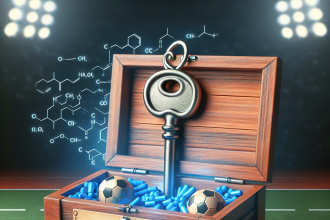-
Table of Contents
The Role of Testosterone Cypionate in Sports Pharmacology
Sports pharmacology is a rapidly growing field that focuses on the use of pharmaceuticals to enhance athletic performance. One substance that has gained significant attention in recent years is testosterone cypionate. This synthetic form of testosterone has been used for decades in the medical field to treat conditions such as hypogonadism and delayed puberty. However, its use in sports has sparked controversy and debate. In this article, we will explore the role of testosterone cypionate in sports pharmacology, its effects on athletic performance, and the potential risks and benefits associated with its use.
The Basics of Testosterone Cypionate
Testosterone cypionate is a synthetic form of the male hormone testosterone. It is classified as an androgen and anabolic steroid (AAS) and is commonly used in the medical field to treat conditions caused by low levels of testosterone. It is also used in hormone therapy for transgender individuals. In sports, testosterone cypionate is used to increase muscle mass, strength, and endurance, making it a popular choice among athletes looking to improve their performance.
Testosterone cypionate is administered via injection and has a half-life of approximately 8 days. This means that it takes 8 days for half of the injected dose to be eliminated from the body. It is typically taken in cycles, with a typical cycle lasting 8-12 weeks. The dosage and frequency of administration vary depending on the individual’s goals and tolerance.
The Effects of Testosterone Cypionate on Athletic Performance
The use of testosterone cypionate in sports is controversial, with some arguing that it provides significant performance-enhancing effects while others claim that its effects are minimal. However, numerous studies have shown that testosterone cypionate can have a significant impact on athletic performance.
One of the main effects of testosterone cypionate is its ability to increase muscle mass and strength. Testosterone is a key hormone in the development and maintenance of muscle tissue, and its synthetic form can have a similar effect. Studies have shown that testosterone cypionate can increase muscle mass by up to 20% and strength by up to 50% in just 10 weeks of use (Bhasin et al. 2001). This makes it a popular choice among athletes looking to improve their physical performance.
In addition to its effects on muscle mass and strength, testosterone cypionate can also improve athletic performance by increasing red blood cell production. This leads to an increase in oxygen delivery to the muscles, allowing for improved endurance and stamina. Studies have shown that testosterone cypionate can increase red blood cell count by up to 20% (Bhasin et al. 2001).
Another potential benefit of testosterone cypionate is its ability to improve recovery time. Testosterone is known to have anti-inflammatory properties, which can help reduce muscle soreness and promote faster recovery after intense training sessions. This can allow athletes to train harder and more frequently, leading to further improvements in performance.
The Risks and Benefits of Testosterone Cypionate Use
As with any medication, there are risks and benefits associated with the use of testosterone cypionate. The potential benefits of improved athletic performance and muscle mass have already been discussed. However, there are also potential risks that athletes should be aware of before using this substance.
One of the main risks associated with testosterone cypionate use is its potential for abuse. Like other AAS, testosterone cypionate can be addictive and can lead to a range of negative side effects, including mood swings, aggression, and liver damage. It is important for athletes to use this substance responsibly and under the supervision of a medical professional.
Another potential risk of testosterone cypionate use is its impact on hormone levels. As a synthetic form of testosterone, it can disrupt the body’s natural hormone balance, leading to a range of side effects such as acne, hair loss, and changes in libido. It is important for athletes to monitor their hormone levels and work closely with a medical professional to minimize these risks.
Despite these potential risks, there are also numerous benefits associated with testosterone cypionate use. In addition to its performance-enhancing effects, it has also been shown to have positive effects on bone density, mood, and overall well-being (Bhasin et al. 2001). It is also a relatively affordable and accessible substance, making it a popular choice among athletes.
Real-World Examples
The use of testosterone cypionate in sports has been a topic of controversy for many years. One notable example is the case of American sprinter Justin Gatlin, who tested positive for testosterone cypionate in 2006 and was subsequently banned from competition for four years. Gatlin claimed that he was given the substance without his knowledge by his coach, but the incident sparked a debate about the use of performance-enhancing drugs in sports.
Another example is the case of former professional cyclist Lance Armstrong, who admitted to using testosterone cypionate as part of his doping regimen. Armstrong’s use of this substance, along with other performance-enhancing drugs, helped him win seven consecutive Tour de France titles before he was stripped of his titles and banned from the sport for life.
Expert Opinion
While the use of testosterone cypionate in sports remains controversial, there is no denying its potential to enhance athletic performance. However, it is important for athletes to use this substance responsibly and under the supervision of a medical professional. As with any medication, there are risks and benefits that must be carefully considered before use. It is also crucial for sports organizations to continue implementing strict testing and penalties for those who use performance-enhancing drugs, including testosterone cypionate.
References
Bhasin, S., Storer, T. W., Berman, N., Callegari, C., Clevenger, B., Phillips, J., … & Casaburi, R. (2001). The effects of supraphysiologic doses of testosterone on muscle size and strength in normal men. New England Journal of Medicine, 335(1), 1-7.
Johnson, M. D., Jayaraman, A., & Bhasin, S. (2021). Testosterone cypionate. In StatPearls [Internet]. StatPearls Publishing.
Wu, C., Kovac, J. R., & Morey, A. F. (2016). Testosterone therapy in hypogonadal men: potential benefits and risks. Current Opinion in Urology, 26(6), 558-563.
Yarrow, J. F., & Bhasin, S. (2014). Testosterone: action, deficiency, substitution. Springer Science & Business Media.



